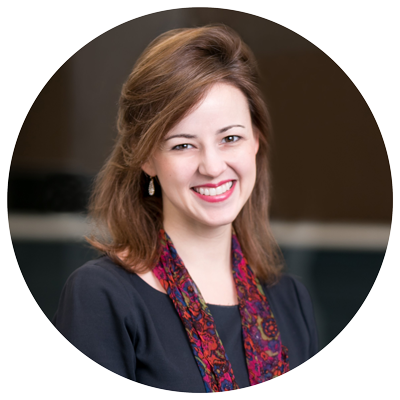On a hot Tuesday evening in the end of June, I sat at the desk in my upstairs bedroom and discussed the current political situation with a couple of my former students over Zoom. The sounds of the neighborhood—crickets, car horns, and people chatting—drifted in through the open window next to me. Suddenly, an amplified voice joined the other sounds—“this has been deemed an unlawful disturbance. Disperse immediately”—so loudly that I thought it was coming from the neighbor’s backyard. I closed the window, and we put the conversation on hold to find out what was going on.
My house is near the Kenton neighborhood in North Portland, a few blocks from the building that houses the Portland Police Association, the union that represents police officers in Portland. That night was the first time I realized there were protests in my area.
Soon, Portland’s protests were the focus of national and international news, after federal law enforcement was sent here to protect the federal courthouse. I started getting texts from friends in other parts of the country—“Are you okay?” “What’s it like?!” Liberal friends wondered if we were being rounded up by the Gestapo. Conservative friends wanted to know if Antifa were burning our houses down.
Liberal friends wondered if we were being rounded up by the Gestapo. Conservative friends wanted to know if Antifa were burning our houses down.
But if it had not been for the disrupted Zoom call, I would hardly have known from my experience that there was civil unrest at all. Even relatives who live here were getting their information mostly from social media or the national news. After a family argument over whether downtown was in fact a “war zone,” it became clear that I would need to find out for myself.
The Justice Center
On a Sunday evening two weeks later, I arrived at the Justice Center around eight o’clock. A crowd of a few hundred stood in front of the building while an older black man with a megaphone addressed the crowd. He spoke about police brutality, and told demonstrators not to light the place on fire. “This building holds black people who have not been convicted of a crime,” he said. “Think about who you’re hurting if you burn it down.” When he was finished, he handed the megaphone to a teenager who told the crowd about the racism he experienced in his rural public high school. Between the speakers, members of the crowd started chants of “No justice, no peace” and “Black lives matter.” Around me, more people were arriving, carrying gas masks, shields, and goggles. A man walked around writing the number for the National Lawyers Guild on people’s arms in Sharpie. After a brief lull, the energy of the crowd picked up again. The “Wall of Moms,” then in their second or third night and before the strange coup that occurred within the organization, were marching up the street to join the crowd, wearing their signature yellow and carrying sunflowers. They formed lines and linked arms in a large square, boxing most of the protesters inside.
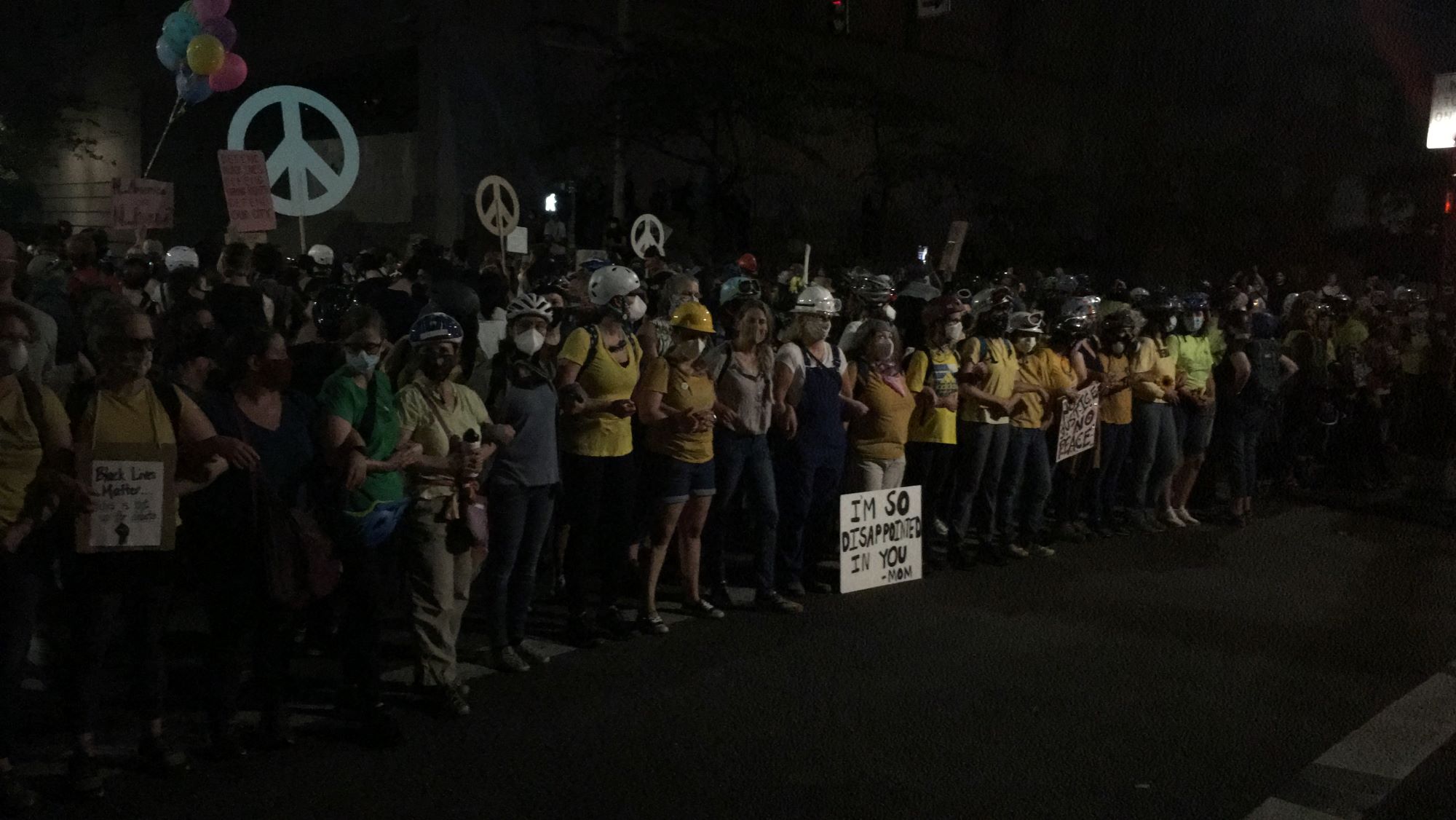
Wall of Moms, photo by Patrick Tomassi
I had come to the demonstration hoping to interview black protesters about what they thought. But I was finding that there were virtually no black people in the crowd. While I was asking a woman from the Wall of Moms to do an interview, another woman walked up. “Ask a black person!” she told me in frustration. I looked around. “I want to—do you see any?” She paused for a moment, then walked off. The mom decided not to be interviewed. Every now and then, a chant of “black lives matter” would begin again.
An announcement came from the federal courthouse next door. “This is the Federal Protective Service. Do not attempt to breach the fence. If you do, crowd-control measures will be used.” The Wall of Moms crumbed on that side, and the entire crowd rushed to the fence in front of the courthouse. A white man in a bulletproof vest pulled down his gas mask to start a chant of “All cops are bastards!” A couple people tried to drown him out with a counterchant of “black lives matter,” but gave up. The chants got louder.
An hour later, I found the older black man who had been leading the protest when I arrived. He was standing with his back to the fence, addressing the protesters who were crushing in on all sides. Cans and pieces of trash were being hurled over our heads at the courthouse. “Stop trying to start something!” he shouted. “What does this have to do with black lives?” An older white man was listening to him, nodding his head. The rest of the crowd was ignoring him. A white woman with an army surplus helmet leaned past us to scream “Fuck you!” several times at the federal police.
The white man grabbed my arm. “Do you want to talk about white privilege? Do you want to see white supremacy? This is white supremacy,” he said.
“Do you want to talk about white privilege? Do you want to see white supremacy? This is white supremacy.”
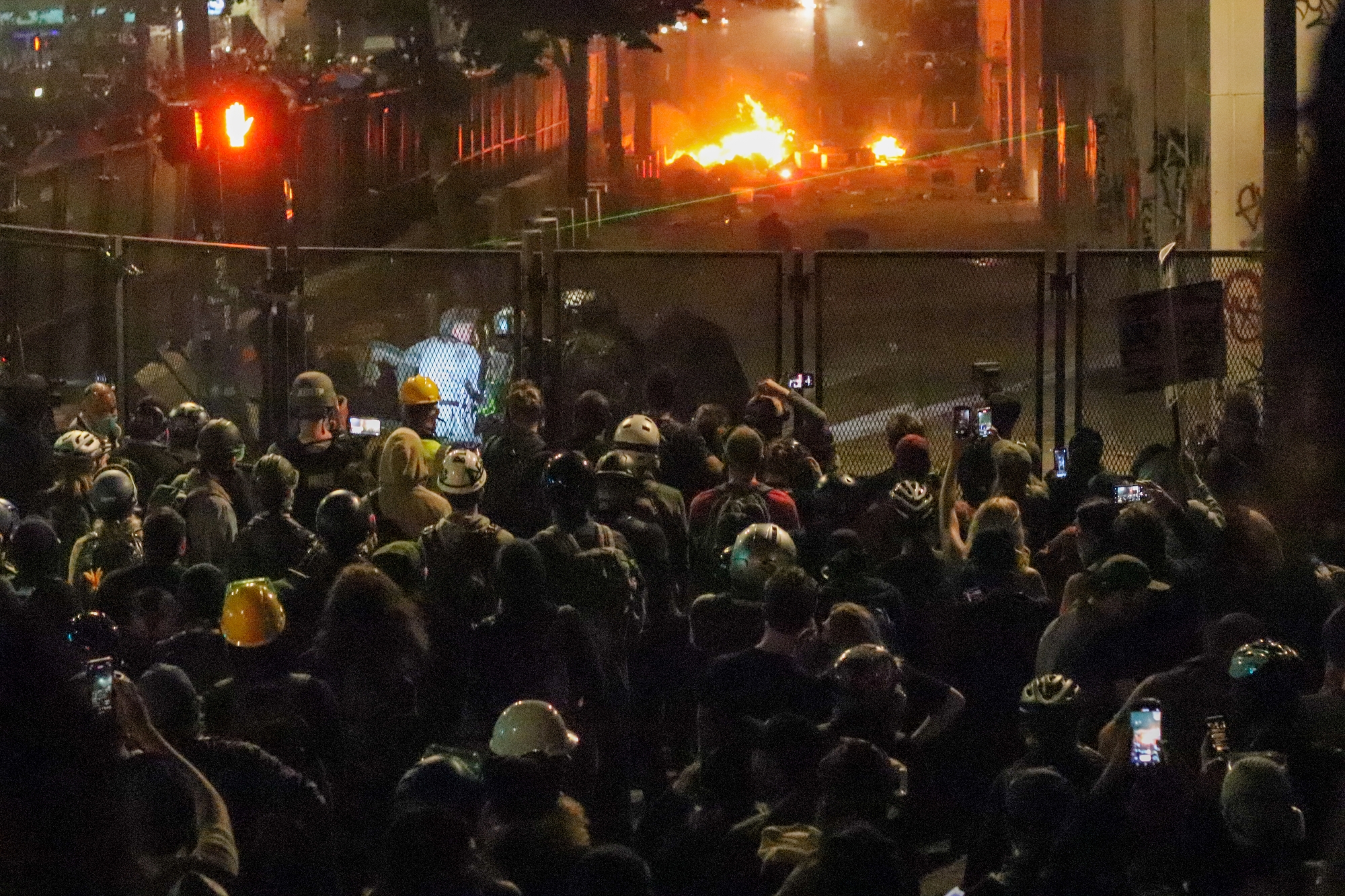
Fires and tear gas at the Mark O. Hatfield Courthouse perimeter fence on July 22, 2020. Photo by Tedder.
The Portland Police Association
A month later, a man crashed his car near a protest in downtown Portland. In a moment that was captured on video and shown repeatedly on the news, he was kicked in the head multiple times by a protester, leaving him unconscious. The next night, I went to a protest in my neighborhood. The flier promoting it read “No cops. No prisons. Total abolition.” When I arrived at Kenton Park, where the protest began, the air was thick with pot smoke. People milled around in the dark and talked with friends, relaying stories of being chased and gassed by police and federal officers. But the energy and excitement of a month ago was absent.
Much had happened in the intervening month. Tensions had built between federal law enforcement and protesters. Protesters broke windows and set fires on government property. Footage compiled by the New York Times showed federal police detaining people in unmarked vans, using teargas, and beating an unarmed and stoic veteran with batons. The protests had grown from hundreds to over ten thousand people, centered on the federal courthouse. After public spats between city and state officials and the Trump administration, the federal officers had been removed from the city, replaced by state police. Then they, too, had been removed. Protesters saw these as victories, signs the movement was succeeding. But members of Portland’s black community had begun to more vocally condemn the co-option they were seeing in the protests. The president of the Portland branch of the NAACP referred to what he saw as “White spectacle.” It is part of a longer-term pattern. Over the past four years, some have claimed, white far-right provocateurs have targeted Portland and been supported by, or at least inconsistently challenged by, the police; they have been met by primarily white protestors, including some from far-left groups such as Rose City Antifa, and interactions between far-left and far-right groups have often ended violently. The culture of protest here is deeply rooted in the history of the city, and it sometimes feels as though the city has chosen itself as a stage on which to play out the nation’s strife.
Just before the crowd began to march, I spoke with the leader, a tall man who identified himself as Matthew. He told me that his goal for the evening was “to be as annoying as possible.” He believed that this was needed to get the community to wake up and join the cause. Matthew related the methods of the current protests to those of the civil rights movement. “If you look back at the pictures and see what’s going on between the hoses, the dogs, the beatings—that was not a pretty thing because everything [the civil rights activists] were doing was highly illegal.” The illegal actions at recent protests, he said, were not so different. He told me that the black leaders who had spoken out against what they were seeing at the protests did not really understand what was happening.
By my headcount, roughly 95 percent of the protesters were white. Matthew and others told me that the whiteness of the protest was reflective of the city’s demographics. Portland is indeed very white, but not as white as the crowd—according to the US Census Bureau, 77 percent of the population is white, and only 6 percent is black. And historically black North Portland, where this protest took place, has more black residents than other parts of the city. While the early protests in Portland were very diverse, the ones that I attended were disproportionately white, even by Portland’s standards. None of the protesters I spoke to would acknowledge what appeared to be evident: Portland’s black community, and not just its leaders, were largely absent.
Matthew made an announcement over the megaphone, and the crowd headed down a side street towards the Portland Police Association. Neighbors stood on the sidewalk, videoing the crowd. A couple of local faith leaders prayed over the protest as it passed. Then a chant began somewhere behind me: “What do we want? Justice! When do we want it? Now! If we don’t get it? Burn it down!”
“What do we want? Justice! When do we want it? Now! If we don’t get it? Burn it down!”
Despite the rhetoric, the energy of the crowd remained fairly low. Someone next to me commented that chants needed to be faster. When we arrived at the PPA building, cars had blocked off the street in both directions. Protesters crowded close to the building initially, but when the police didn’t materialize they spread out in the open space, smoking, talking to friends, and milling around. A handful of people graffitied the building or attempted to pry off the plywood that had been used to board up the windows. Chants started and fizzled out sporadically. A man bought a couple of boxes of donuts at Heavenly Donuts, a twenty-four-hour shop across the street from the PPA building, and brought them around to the crowd. “It’s hard being out here,” he told me. “These people are out here every night.” He said that the people who own the donut shop are good people who need the business. “And who doesn’t need a sprinkled donut when you’re trying to change the world?” There were no speeches. Someone plugged in a speaker and started to play a recording of a black woman talking about what it’s like to be black in America. Few appeared to be listening. I had the sense that we were all just waiting for something to happen, waiting for the enemy to arrive.
When Joey Gibson, the Irish-Japanese leader of the alt-right-adjacent group Patriot Prayer, and by that point a well-known figure in Portland, showed up, it was like someone had turned on the lights. “Do you stand by what happened last night?” he asked through a megaphone he had brought, referring to the attack on the man who crashed his truck. “Go home, Joey!” the crowd responded, following him across the street. Several people held up their phones to livestream the action. Someone threw a Slurpee, which missed Gibson and hit the windshield of a car. A voice from below me and to the left screamed, “Don’t touch him!” and a woman tore off through the crowd in her wheelchair, placing herself between Mr. Gibson and the rest of the protesters.
“Do you stand by it?” Mr. Gibson asked the crowd again. “No,” the woman responded. “It should never have happened.” After a couple minutes, Mr. Gibson walked away from the crowd, covering his eyes with his hands. Apparently someone had maced him. The woman in the wheelchair found water and helped him get the mace out of his eyes, while a few people stood by livestreaming the encounter. At one point, a Latino man walked up and told Gibson that “your racist ass needs to do something.” “I’m darker than you!” Gibson responded, holding out his arm. They yelled at each other for several minutes, the other man at one point calling Gibson “a Japanese white fellow that’s darker than me.”
The woman in the wheelchair was Amanda Siebe, a disability rights activist from Portland. I spoke with her after she finished helping Mr. Gibson get the mace out of his eyes. As we spoke, she smoked a cigar. “The last thing I wanted was more violence,” she told me. “If we turn to violence, then the movement is dead. We can’t let that happen.” She said that Mr. Gibson had come to the protest hoping to get hit, so that that would be the headline, and she wasn’t going to allow that to happen. She said she felt safe doing what she did, because she knew that the protesters had her back. Although Ms. Siebe is white, for her, the protests are personal. “Justice, equality, and dignity aren’t necessarily racial things,” she told me. “Half of those killed by police are disabled.” This number comes from a 2016 meta-analysis; the study notes that in most of these incidents, that disability is psychological or cognitive. If one adds in those killed by police who are under the influence of drugs or alcohol, the percentage rises to 81 percent, one study has shown.
I asked Ms. Siebe about the lack of black people at the protest. “That reflects our city,” she told me. “If you look around what you see here is a lot of people using the white privilege that they have to try to make change for the black community.” Ms. Siebe said that there were not more black people because of the risk of interacting with the police. “At some point we have to step up as white people and use that white privilege to help protect people.”
Kenton Plaza
A couple of weeks before the protest I attended in Kenton, the businesses along Denver, the main street, began using the road for outdoor seating. The restaurants and coffee shops had been hit hard by the pandemic, and welcomed the opportunity to rebound. The Kenton Business Association raised nearly $15,000 on GoFundMe to convert the space. The approach is called lean urbanism: adapt a space that has been car-focused to make it people-focused, with imagination but with minimal infrastructure changes. It’s the same kind of adaptation that cities around the world have made to the virus: suddenly, everywhere is a sidewalk café. City officials placed barricades at the ends of the street to pedestrianize it. Parking spaces were cordoned off and picnic tables with umbrellas set up in them. Residents and local artists painted a colorful pattern over half the road to give it the feel of a plaza, and restaurants set up tables and chairs. Posies Bakery and Cafe, Swift & Union, Po’Shines, Kenton Station, Casa Maya, Fino: local places, working out ways to pull through the crisis, working out ways to keep themselves afloat and keep the neighborhood alive.
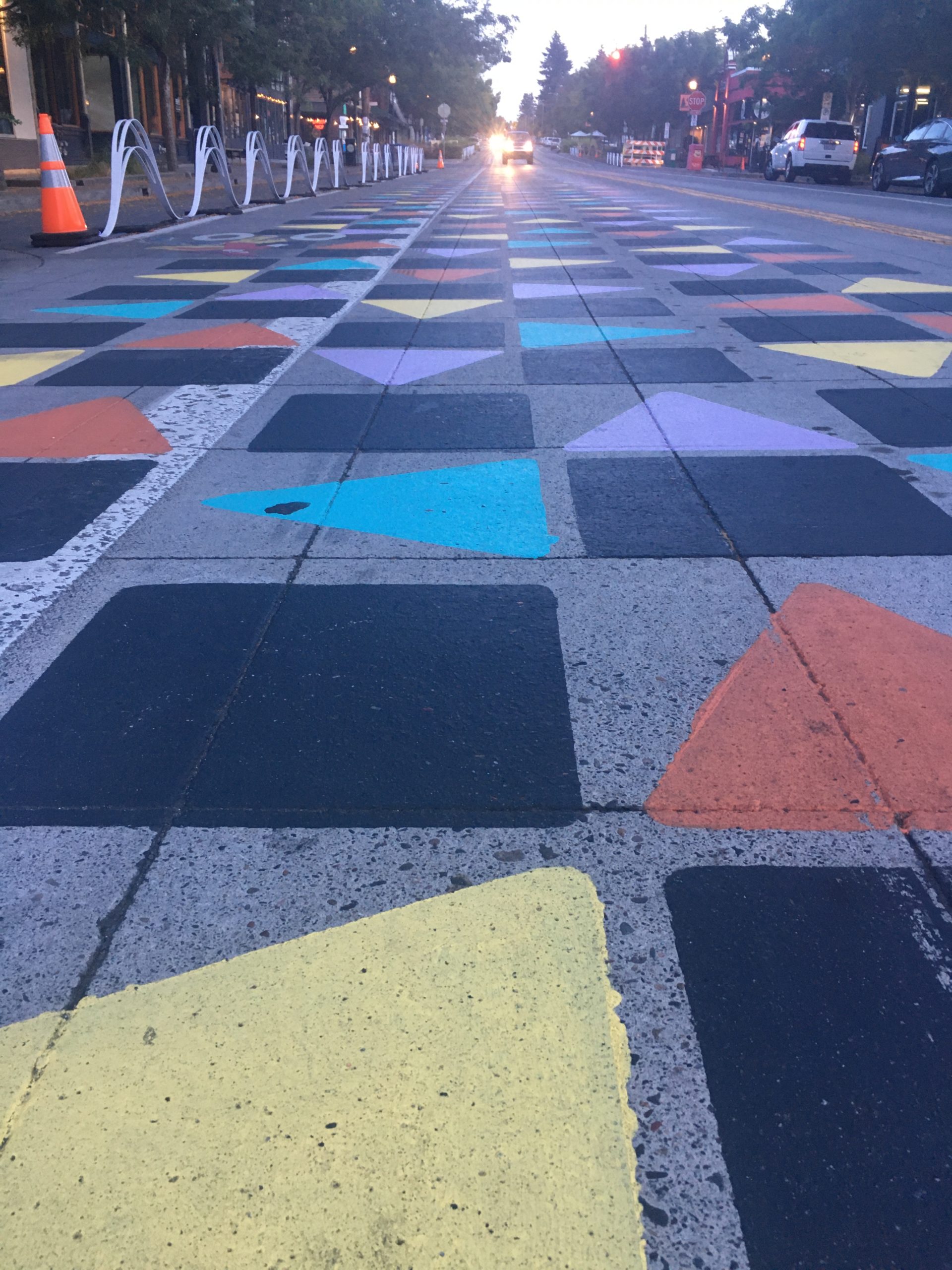
Kenton Plaza. Photo by Patrick Tomassi.
Shortly after midnight later that week—it was early in the morning on August 9, on the seventy-third subsequent night of the protests—protestors managed to set a small fire inside the Portland Police Association building, right down the road from the plaza area. It was the second time protestors had done this—as reported by the Oregonian, they had punched a hole in the plywood that the police association building had nailed up over its door, and set debris ablaze just inside. Several minutes after this happened, the police declared the gathering a riot, and dozens of officers began pressing the crowd back, using pepper spray and rubber bullets. Protesters retreated as far as the pedestrianized strip along Denver, and barricaded the road more than it had already been barricaded by the city, piling up picnic tables and wooden road signs. Then they lit trash cans on fire, and tossed the stencils that had been used to paint the street on top.
It’s important to stress that not all protestors were involved in this—Ms. Siebe and others want no part in this violence. But from what I have seen and what others who were there have told me, the arsonists were drawn from the crowd that was at the PPA building. These night protests are smaller than the largest of Portland’s protests from several months ago—there are usually a couple of hundred people per night. But at this point, daytime protests have mostly stopped. What is left is night after night of a similar pattern: the situation between protestors and cops becomes more and more heated until a protestor does something bad enough for the cops to declare a riot and attempt to clear everyone out—often with teargas and other such methods. Between May 29 and August 27, the police have declared twenty-three riots and twenty-two unlawful assemblies. You’ll hear it over the loudspeaker, after things get hot enough each evening: “This is the Portland Police Bureau. We’re declaring this a riot. You need to leave the area to the west. If you do not leave the area, you may be subject to use of force to include crowd-control munitions, pepper spray, or teargas.” The Portland Police Bureau has put out a much-publicized video explaining what constitutes a riot. They order those who are peacefully protesting to leave, after the declaration is made. Usually, some people do leave. Those who don’t put on gas masks and prepare for conflict.
That night, the fires were put out by business owners and residents of the Kenton neighborhood, in an effort led by Terrance Moses and a few others. Mr. Moses owns a computer repair shop in Kenton called TECH NET EZ. He is also the chair of the Kenton Neighborhood Association, and belongs to the Kenton Business Association. He is on the neighborhood board supporting the Kenton Women’s Village, a tiny-home-model transitional housing project managed by Catholic Charities, and runs a nonprofit that collects trash and provides food and clothing for houseless neighbors in North Portland. Mr. Moses went out after midnight with others to try to prevent the Kenton Plaza from being destroyed.
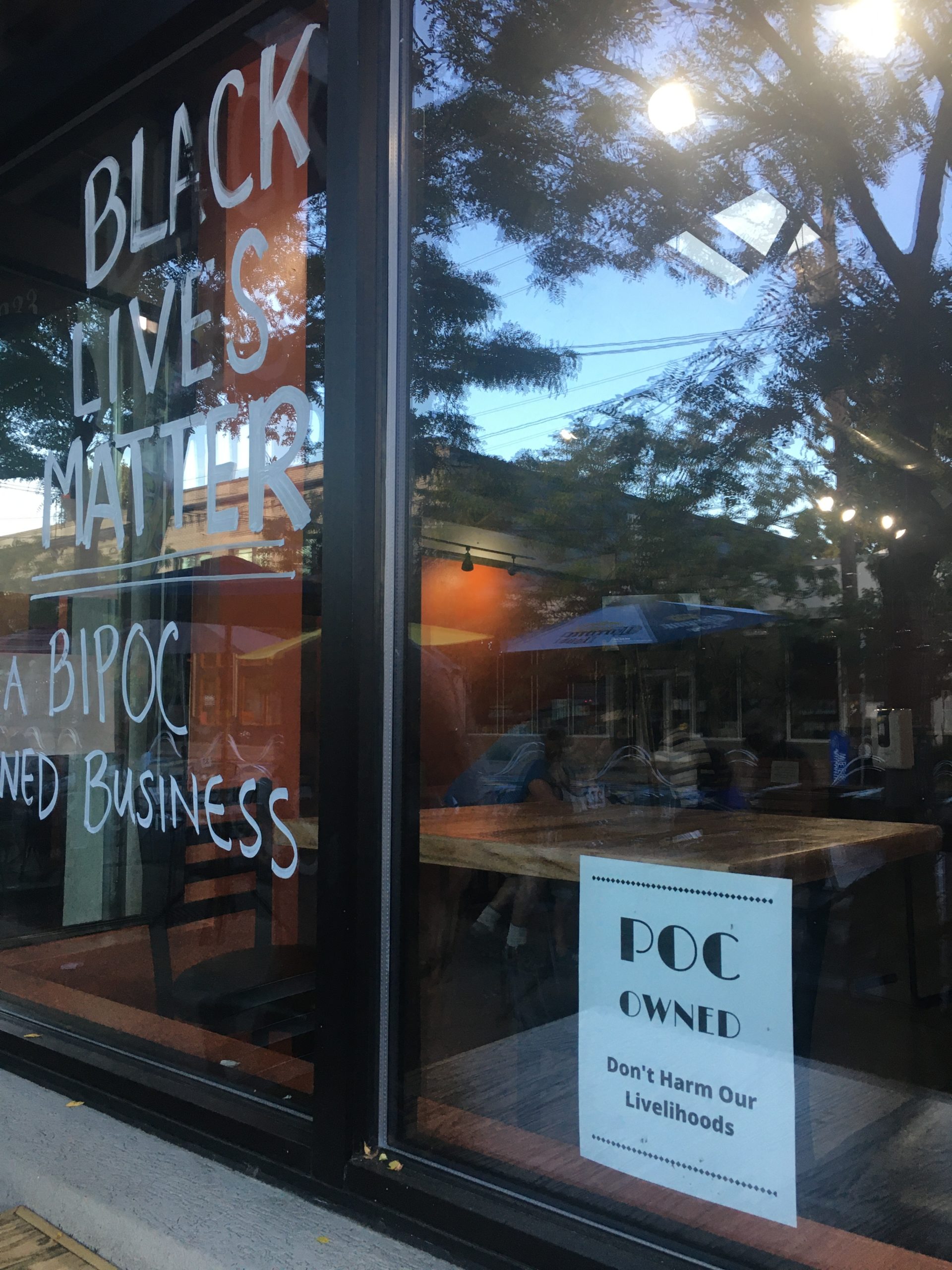
Casa Maya sign. Photo by Patrick Tomassi.
When Mr. Moses, who is black, moved to Kenton twenty-six years ago, it was a black neighborhood that was safe and affordable to live in. Things have changed, though: the house across the street from him is now worth half a million dollars. He has watched as members of the black community in Kenton have been priced out, and now hears some white people argue against efforts to create affordable housing.
I spoke to Mr. Moses outside his garage, where he runs his nonprofit. We stood next to the truck and trailer he uses to distribute food and clothing. Large signs with George Floyd’s face and captions of “I can’t breathe” and “8:46” adorn three sides of the trailer. Mr. Moses said that, when the protests began in May, he thought, “Finally, someone’s standing up. Something’s going to be done.” He had been silent about the unfair treatment of black people by law enforcement for too long, he said. The protests emboldened him to become vocal.
But early on, he started to see things take a shift. The protests stopped being about black lives and started being about other agendas. “To see businesses get their windows smashed and stuff burnt up—that’s not what black folks are looking for,” he told me. He said that black people want to be recognized as human, to receive equal treatment under the law, to be given the same rights and the same treatment that white people enjoy.
“To see businesses get their windows smashed and stuff burnt up—that’s not what black folks are looking for.”
When the protest moved into the Kenton Plaza, where many of the businesses are owned by people of color, Mr. Moses was one of the first people there. He ran buckets of water from the pizza shop to put out the fires. Picnic tables from a restaurant had been turned upside down and tossed onto the flames. “What’s so sad about it is that as fast as we put it out, they would relight them,” he told me. “They were relighting them as we were there trying to put them out. Now that doesn’t say anything about Black Lives Matter or coming together in solidarity or support. This is just destruction for the sake of destruction—and out in front of seven people of color’s businesses right here.” Those businesses are his computer repair shop, three restaurants—Po’Shines, Casa Maya, and Derby—a corner store called the Triple Crown Market, a smoke shop, and—Portland being Portland—a weed shop.
“This is how you support us?” went on Mr. Moses,
By setting our businesses on fire and destroying the property? Most of the west side of Denver is people-of-color-owned businesses—those are what were getting trashed. It’s infuriating to see them come down there and chant Black Lives Matter, throw stuff in the fires, set fires, tag buildings—“No Justice, No Peace!”—in the name of BLM. You say that, but you’re tearing up all these businesses that are black- or people-of-color-owned.
“Stop and listen to us.”
Mr. Moses said what he wants from the protests is simple. “Stop and listen to us. Don’t keep telling us how you want us to be. Let us tell you what we need. Don’t assume what we need and just run with it.”
Coda: As of publication, Portland’s nighttime protests have been going on for one hundred days. The same pattern persists.





